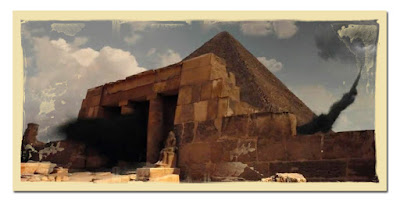The Sorcerer's Apprentice was on the telly a few days ago. The movie from 2010 is a very loosely based on Goethe’s poem of the same name written in 1797. Nicolas Cage plays the centuries old magician Balthazar Blake who tries to save the world from the mad sorceress Morgana le Fay. She plans to raise an army of dead wizards to destroy the world. A mysterious ritual is required to resurrect her evil followers around the world, from Paris to ancient Egypt. A dark cloud rages over the planet to the myriad graves of Morganas disciples. When the cloud arrives in Egypt the correspondent scene shows the facade of a tomb at the Giza plateau, southeast of the great pyramid of pharaoh Khufu.
 |
| The Sorcerer's Apprentice (c) Walt Disney Pictures |
 |
| The entrance to Seshem-nefers tomb |
But Seshem-nefer was no wizard.
 |
| The Sorcerer's Apprentice (c) Walt Disney Pictures |
 |
| The Ramesseum in Thebes |
But which one of the age-old wizards of pharaonic Egypt could this statue represent?
There aren't many names preserved in the ancient record, but one of the cardinal sources for fabled magicians is the papyrus Westcar. This papyrus scroll is more than 3500 years old and is now on display in the Egyptian Museum Berlin. The text contains five tales about a number of powerful wizards and their magical deeds. Most of these tales are told to pharaoh Khufu by his sons.
The protagonist of one of them is the priest and sorcerer Ubaoner. His name means "the one who splits stones". He is betrayed by his wife who is unfaithful to him. She has an affair with a lesser man and often meets him in a summer house in the middle of a pond. The sorcerer Ubaoner realizes their foul play and plots revenge. He forms a seven fingers long crocodile of wax and casts a spell over it. When his wife is visited again by her lover she is waiting for him on an island in the pond. So he has to swim there. As soon as the man gets into the water Ubaoner throws the crocodile into it and the figurine grows to the full size of seven cubits (almost four metres). The now tremendous beast catches the adulterer and drags him to the ground of the lake. He is never seen again and no one knows where the beast might have brought him. Ubaoners wife on the other hand was taken to the region north of the royal residence. There she was burnt and her ashes were scattered over the river, an incredible cruel fate that deprives her of the chance to live and prosper in the nether regions.
So Ubaoner was clearly a powerful and maybe gruesome mage, but was he evil enough to qualify as one of Morganas disciples? Probably not, but who knows? ;-)
Sources:
M. Lichtheim, Ancient Egyptian literature: a book of readings. The Old and Middle Kingdoms I (University of California Press 2000) S. 215–220;
A. M. Blackman, The story of King Kheops and the magicians : transcribed from Papyrus Westcar (Berlin Papyrus 3033) (Reading 1988)

No comments:
Post a Comment